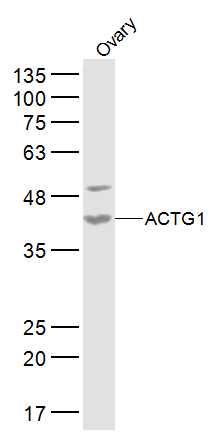
Rabbit Anti-ACTG1 antibody
ACT; ACTB; ACTG; ACTG_HUMAN; actg1; Actin, cytoplasmic 2; Actin, gamma 1; Actin, gamma 1 propeptide; cytoplasmic 2; Cytoskeletal gamma actin; Deafness, autosomal dominant 20; Deafness, autosomal dominant 26; DFNA20; DFNA26; N-terminally processed.
View History [Clear]
Details
Product Name ACTG1 Chinese Name 肌动蛋白γ1抗体 Alias ACT; ACTB; ACTG; ACTG_HUMAN; actg1; Actin, cytoplasmic 2; Actin, gamma 1; Actin, gamma 1 propeptide; cytoplasmic 2; Cytoskeletal gamma actin; Deafness, autosomal dominant 20; Deafness, autosomal dominant 26; DFNA20; DFNA26; N-terminally processed. Research Area Signal transduction Cytoskeleton Immunogen Species Rabbit Clonality Polyclonal React Species Mouse, (predicted: Human, Rat, Chicken, Dog, ) Applications WB=1:500-2000 IHC-P=1:100-500 IHC-F=1:100-500 ICC=1:100-500 IF=1:100-500 (Paraffin sections need antigen repair)
not yet tested in other applications.
optimal dilutions/concentrations should be determined by the end user.Theoretical molecular weight 42kDa Cellular localization cytoplasmic Form Liquid Concentration 1mg/ml immunogen KLH conjugated synthetic peptide derived from human ACTG1: 1-100/375 Lsotype IgG Purification affinity purified by Protein A Buffer Solution 0.01M TBS(pH7.4) with 1% BSA, 0.03% Proclin300 and 50% Glycerol. Storage Shipped at 4℃. Store at -20 °C for one year. Avoid repeated freeze/thaw cycles. Attention This product as supplied is intended for research use only, not for use in human, therapeutic or diagnostic applications. PubMed PubMed Product Detail Actins are highly conserved proteins that are involved in various types of cell motility, and maintenance of the cytoskeleton. In vertebrates, three main groups of actin isoforms, alpha, beta and gamma have been identified. The alpha actins are found in muscle tissues and are a major constituent of the contractile apparatus. The beta and gamma actins co-exist in most cell types as components of the cytoskeleton, and as mediators of internal cell motility. Actin, gamma 1, encoded by this gene, is a cytoplasmic actin found in non-muscle cells. Mutations in this gene are associated with DFNA20/26, a subtype of autosomal dominant non-syndromic sensorineural progressive hearing loss. Alternative splicing results in multiple transcript variants.[provided by RefSeq, Jan 2011]
Function:
Actins are highly conserved proteins that are involved in various types of cell motility and are ubiquitously expressed in all eukaryotic cells.
Subunit:
Polymerization of globular actin (G-actin) leads to a structural filament (F-actin) in the form of a two-stranded helix. Each actin can bind to 4 others.
Subcellular Location:
Cytoplasm, cytoskeleton.
Post-translational modifications:
The methylhistidine determined by Bienvenut et al is assumed to be the tele-methylhistidine isomer by similarity to the mouse ortholog.
Oxidation of Met-44 and Met-47 by MICALs (MICAL1, MICAL2 or MICAL3) to form methionine sulfoxide promotes actin filament depolymerization. MICAL1 and MICAL2 produce the (R)-S-oxide form. The (R)-S-oxide form is reverted by MSRB1 and MSRB2, which promote actin repolymerization.
Monomethylation at Lys-84 (K84me1) regulates actin-myosin interaction and actomyosin-dependent processes. Demethylation by ALKBH4 is required for maintaining actomyosin dynamics supporting normal cleavage furrow ingression during cytokinesis and cell migration.
DISEASE:
Deafness, autosomal dominant, 20 (DFNA20) [MIM:604717]: A form of non-syndromic sensorineural hearing loss. Sensorineural deafness results from damage to the neural receptors of the inner ear, the nerve pathways to the brain, or the area of the brain that receives sound information. Note=The disease is caused by mutations affecting the gene represented in this entry.
Baraitser-Winter syndrome 2 (BRWS2) [MIM:614583]: A rare developmental disorder characterized by the combination of congenital ptosis, high-arched eyebrows, hypertelorism, ocular colobomata, and a brain malformation consisting of anterior-predominant lissencephaly. Other typical features include postnatal short stature and microcephaly, intellectual disability, seizures, and hearing loss. Note=The disease is caused by mutations affecting the gene represented in this entry.
Similarity:
Belongs to the actin family.
SWISS:
P63261
Gene ID:
71
Database links:Entrez Gene: 71 Human
Entrez Gene: 11465 Mouse
Omim: 102560 Human
SwissProt: P63261 Human
SwissProt: P63260 Mouse
Unigene: 514581 Human
Unigene: 196173 Mouse
Unigene: 426706 Mouse
Unigene: 101464 Rat
Unigene: 106826 Rat
Product Picture
Partial purchase records(bought amounts latest0)
No one bought this product
User Comment(Total0User Comment Num)
- No comment



 +86 571 56623320
+86 571 56623320




